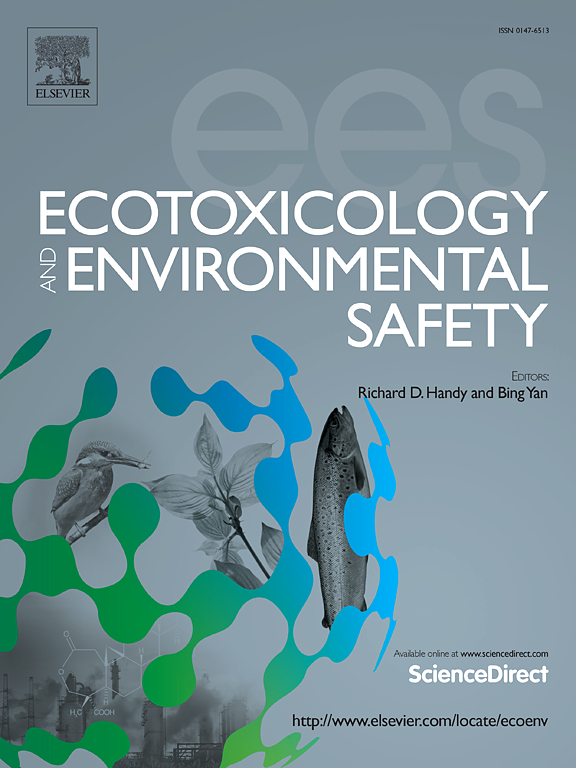Physiological and biochemical responses of pepper (Capsicum annuum) to cadmium stress: The mitigating effects of exogenous abscisic acid
IF 6.2
2区 环境科学与生态学
Q1 ENVIRONMENTAL SCIENCES
引用次数: 0
Abstract
The production of pepper is increasingly challenged by cadmium (Cd) contamination. Abscisic acid (ABA) is supposed to alleviate Cd-induced toxicity and reduce the accumulation of Cd. However, the underlying physiological mechanisms by which ABA regulates Cd tolerance remain unclear. Therefore, this study investigates the mitigation of Cd toxicity in pepper exposed to Cd stress through the application of exogenous ABA under hydroponic conditions. The analysis focused on the subcellular distribution of Cd in the root, its localization in cell wall polysaccharide components, and the associated physiological indices. The results showed that ABA treatment significantly reduced Cd accumulation in pepper roots and shoots, which suggests that ABA effectively decreases Cd translocation from roots to aboveground tissues. This was accompanied by enhanced antioxidant activity, as evidenced by increased peroxidase and catalase activities. Furthermore, ABA regulated the subcellular distribution of Cd in root tissues, decreased Cd content in the cell wall and thereby mitigating Cd toxicity at the cellular level. The addition of ABA also reduced the content of hydrogen peroxide and malondialdehyde, indicating a reduction in lipid peroxidation and cell membrane damage. These findings highlight that ABA can enhance plant tolerance to Cd stress by modifying Cd distribution within the plant, boosting the antioxidant defense mechanism, and altering cell wall composition to limit Cd absorption. This study suggests that exogenous ABA could be a potential strategy for improving Cd resistance in pepper and reducing Cd contamination in crops.
辣椒(Capsicum annuum)对镉胁迫的生理生化反应:外源脱落酸的缓解作用
辣椒生产日益受到镉(Cd)污染的挑战。脱落酸(ABA)被认为可以减轻Cd诱导的毒性,减少Cd的积累。然而,ABA调节Cd耐受性的潜在生理机制尚不清楚。因此,本研究探讨了水培条件下外源ABA对镉胁迫下辣椒Cd毒性的缓解作用。重点分析了Cd在根中的亚细胞分布、Cd在细胞壁多糖成分中的定位及其相关生理指标。结果表明,ABA处理显著降低了辣椒根和茎中Cd的积累,表明ABA有效地减少了Cd从根向地上组织的转运。这伴随着抗氧化活性的增强,如过氧化物酶和过氧化氢酶活性的增加所证明的。此外,ABA调节了Cd在根组织中的亚细胞分布,降低了细胞壁中Cd的含量,从而在细胞水平上减轻了Cd的毒性。ABA的添加也降低了过氧化氢和丙二醛的含量,表明脂质过氧化和细胞膜损伤的减少。这些结果表明,ABA可以通过改变Cd在植物体内的分布、增强抗氧化防御机制和改变细胞壁组成来限制Cd的吸收,从而增强植物对Cd胁迫的耐受性。本研究提示外源ABA可能是提高辣椒抗Cd性和减少作物Cd污染的潜在策略。
本文章由计算机程序翻译,如有差异,请以英文原文为准。
求助全文
约1分钟内获得全文
求助全文
来源期刊
CiteScore
12.10
自引率
5.90%
发文量
1234
审稿时长
88 days
期刊介绍:
Ecotoxicology and Environmental Safety is a multi-disciplinary journal that focuses on understanding the exposure and effects of environmental contamination on organisms including human health. The scope of the journal covers three main themes. The topics within these themes, indicated below, include (but are not limited to) the following: Ecotoxicology、Environmental Chemistry、Environmental Safety etc.

 求助内容:
求助内容: 应助结果提醒方式:
应助结果提醒方式:


